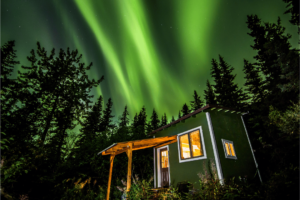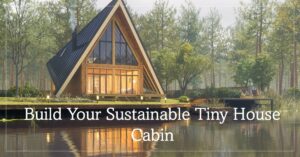Mastering the Art of Tiny House Budgeting: Unpack the Costs and Considerations
Tiny houses have captured the imagination of many, offering a minimalist, eco-friendly, and budget-conscious alternative to traditional housing. If you’re curious about the financial aspects of tiny house living, you’re not alone.
Let’s take a closer look at the factors that influence the cost of tiny houses, providing you with the insights you need to make an informed decision.
Budgeting for Tiny House Living
When contemplating the cost of a tiny house, potential owners want to understand whether this lifestyle aligns with their financial situation. Tiny houses can vary significantly in price, making it crucial to budget accurately.
Size, location, and customization play a substantial role in determining expenses. Whether you’re aiming for a budget-friendly or a more luxurious tiny home, establishing your financial parameters is the first step towards realizing your tiny house dream.
Whether planning to build a tiny house or move into an existing one, here’s a step-by-step guide on budgeting effectively for tiny house living.
1. Determine Your Total Income:
● Calculate your monthly income, including wages, rental income, investments, and any other sources of revenue. This forms the basis of your budget.
2. Identify Essential Expenses:
● Start by listing your essential monthly expenses, such as:
● Mortgage or rent (if applicable)
● Utilities (water, electricity, gas)
● Food and groceries
● Health insurance
● Transportation (fuel, maintenance, insurance)
● Debt payments (credit cards, loans)
● Ensure that these essentials are prioritized in your budget.
3. Estimate Tiny House Costs:
● Determine the total cost of your tiny house, including:
● Construction or purchase price
● Land or parking fees (if you’re not on wheels)
● Permits and inspections
● Construction materials
● Furnishings and appliances
● Break these costs into manageable monthly amounts if you save for your tiny house or pay off a loan.
4. Include Ongoing Tiny House Expenses:
● Consider monthly expenses related to your tiny house, such as:
● Insurance (homeowners or renters insurance)
● Maintenance and repairs
● Property taxes (if applicable)
● Propane or heating fuel (if off-grid)
● Waste disposal (if off-grid)
5. Plan for Lifestyle Expenses:
● Allocate funds for discretionary spending, which might include:
● Entertainment
● Dining out
● Hobbies and interests
● Travel and vacations
● Personal care
6. Account for Emergency Savings:
● Build an emergency fund to cover unexpected expenses, such as medical bills or urgent repairs. Aim to set aside at least three to six months’ living expenses.
7. Track Your Spending:
● Monitor your spending meticulously to ensure you’re staying within your budget. There are various budgeting apps and tools available to help with this.
8. Adjust and Refine:
● Periodically review your budget and make adjustments as necessary. Life circumstances change, and your budget should adapt accordingly.
9. Consider Sustainability and Self-Sufficiency:
● Explore ways to make your tiny house lifestyle more sustainable and self-sufficient, such as:
● Implementing energy-efficient practices
● Growing your food
● Harvesting rainwater
● Generating solar power
● Reducing waste
10. Seek Financial Advice if Needed: – If you need more clarification about budgeting for tiny house living, consider consulting with a financial advisor specializing in alternative and sustainable housing.
Creating a budget for tiny house living may require some initial effort. Still, ensuring that your transition to this unique lifestyle is financially viable and fulfilling is crucial. By carefully managing your finances, you can fully embrace the benefits of tiny house living while maintaining financial security and peace of mind.
Comparing Tiny House Costs to Traditional Housing
Comparing costs to conventional housing options is a natural inclination for those considering tiny houses. This comparison stems from the desire to gauge the financial feasibility of tiny living.
People often wonder whether the financial savings of tiny houses are substantial enough to warrant the downsizing and lifestyle changes. Understanding how tiny house costs measure up against traditional homes and apartments can help determine whether it’s a practical and cost-effective choice for your housing needs.
The cost of a tiny house versus traditional housing can vary significantly depending on various factors, and there isn’t a one-size-fits-all answer. Here are some key points to consider
Tiny House Costs:
- Lower Initial Investment: Tiny houses typically have a lower upfront cost than traditional homes. Basic DIY tiny houses can be inexpensive, but professionally built or custom-designed tiny dwellings can still be more affordable than conventional homes.
- Reduced Operating Expenses: Tiny houses often have reduced utility bills and maintenance costs due to their smaller size. They are also designed to be energy-efficient, which can result in long-term savings.
- Minimalist Lifestyle: Living in a tiny house encourages a simpler, more minimalist lifestyle, which can lead to savings on possessions, as you’ll have less space to fill with belongings.
Traditional Housing Costs:
- Higher Initial Investment: Traditional homes typically have a higher upfront cost due to their larger size and the cost of land or property.
- Higher Operating Expenses: Larger homes often come with higher utility bills and maintenance costs. Heating, cooling, and general upkeep can be more expensive.
- Property Taxes and Insurance: Traditional homes may incur higher property taxes and insurance costs than tiny houses.
Considerations:
● Location: The cost of housing varies significantly by location. In some areas, the price of traditional homes may be much higher than the cost of tiny houses, while in other regions, the opposite may be true.
● Lifestyle: Consider your lifestyle and space needs. Tiny houses are a suitable choice for those who are comfortable with a downsized lifestyle. Traditional homes offer more space and are often more suitable for families.
● Resale Value: Traditional homes tend to appreciate in value over time, while tiny houses may not appreciate as rapidly. This can affect your long-term financial outlook.
Ultimately, whether a tiny house is more costly than traditional housing depends on your circumstances, lifestyle preferences, location, and long-term financial goals. It’s essential to carefully assess your needs, budget, and priorities when deciding between tiny house living and traditional housing.
Investment Potential and Income Generation
Another consideration in understanding tiny house costs is the potential for investment and income generation. Some individuals view tiny houses as more than just a place to live; they see them as opportunities for financial growth. This could entail renting out their tiny house as an Airbnb, creating a secondary source of income. By understanding the costs involved, including initial investments and potential returns, you can decide whether a tiny house aligns with your investment goals.
The Varied Costs of Tiny House Living
Tiny house costs can vary significantly based on several factors, including location, size, and customization. Understanding these variables is essential when budgeting for your tiny house project. Whether you’re looking for a cost-effective solution or planning a more luxurious tiny home, knowing the factors influencing costs is crucial.
Here’s a sample breakdown of how the costs for a tiny house might be distributed:
1. Construction Costs:
● Trailer or foundation: $5,000 – $15,000
● Building materials (lumber, insulation, siding, roofing, etc.): $10,000 – $30,000
● Labor (if hiring builders): $5,000 – $20,000
● Permits and inspections: $1,000 – $5,000
2. Interior Finishes and Appliances:
● Kitchen appliances (stove, refrigerator, sink, etc.): $2,000 – $10,000
● Bathroom fixtures (shower, toilet, sink): $1,500 – $5,000
● Flooring, cabinets, countertops: $2,000 – $10,000
● Heating and cooling system (e.g., mini-split AC/heat pump): $2,000 – $5,000
● Furniture and storage solutions: $1,000 – $5,000
3. Utility Connections:
● Plumbing and water system: $1,000 – $5,000
● Electrical wiring and fixtures: $1,000 – $5,000
● Off-grid systems (solar panels, batteries, composting toilet, etc. – if applicable): $5,000 – $20,000
4. Miscellaneous Costs:
● Land or parking spot (if not already owned): Varies widely by location
● Insurance (homeowners or renters insurance): $500 – $1,000 annually
● Maintenance and repairs (annual estimate): $1,000 – $2,000
5. Customization and Upgrades:
● Custom features (e.g., built-in storage, unique design elements): Variable, depending on personal preferences
● Luxury finishes and appliances: Variable, but can significantly increase costs
6. Total Estimated Cost Range:
● Basic DIY tiny house: $20,000 – $60,000
● Professionally built, mid-range tiny house: $50,000 – $100,000
● Luxury custom tiny house: $100,000 – $250,000 or more
Please note that these figures are rough estimates and can vary based on location, local building codes, and material choices. It’s essential to research costs specific to your region and consult with builders or experts in tiny house construction to get a more accurate estimate for your unique project. Additionally, don’t forget to budget for ongoing expenses such as land or parking fees, utilities, and maintenance when planning for tiny house living.
Realistic Expectations
Managing your expectations regarding the cost of tiny house living is essential. While tiny houses can offer significant savings compared to traditional homes, other factors like land, utilities, and ongoing maintenance costs may offset some of those savings. Being aware of these factors will help you make a more informed decision.
On the lower end, a DIY tiny house project might cost anywhere from $10,000 to $30,000 if you’re skilled at construction and can source affordable materials. These DIY tiny houses are often simpler in design and may not include high-end finishes or appliances.
For professionally built, ready-to-move-in tiny houses, prices typically start at around $30,000 to $50,000 for a basic model with essential amenities. Mid-range tiny houses with more features and customization options can range from $50,000 to $100,000.
Luxury tiny houses, with high-end finishes, premium appliances, and extensive customizations, can cost anywhere from $100,000 to $250,000 or even more.
Remember that the cost of land or a parking spot for your tiny house is an additional consideration, and this cost can vary significantly depending on the location and local real estate market.
It’s important to research current prices in your area and from different tiny house builders to get a more accurate estimate. Additionally, if you plan to build your tiny house, carefully budget for materials, labor (if needed), and permits, the cost of living in a tiny house can also be influenced by factors such as utility bills, maintenance, and lifestyle choices, so it’s essential to consider all these aspects when budgeting for tiny house living.
Sustainability Considerations
Many individuals are drawn to tiny houses for their sustainability benefits. They want to know if the cost of building or buying a tiny home aligns with their eco-conscious lifestyle goals. Factors like using sustainable materials and off-grid systems can impact costs while contributing to a greener way of living.
Customization and Design Choices
One of the unique aspects of tiny houses is the high degree of customization they offer. Suppose you want specific design choices, such as solar panels, off-grid systems, or luxury finishes. In that case, it’s essential to understand how these choices can affect the overall cost of your tiny house project.
Final Thoughts
In conclusion, understanding the costs of tiny house living is a multifaceted endeavor. Whether you’re budgeting, comparing options, considering investment potential, or exploring sustainability, being informed about the financial aspects of tiny houses is essential.
By delving into these considerations, you can make a well-informed decision about whether tiny house living is right for you.





